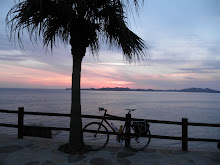98.0 km; 4hr 59min; (19.6km/h) Temples 1-12
The night bus from Yokohama to Matsushige was remarkably comfortable, 3 single seats in a row and even enough leg room for me to recline and get a decent nights sleep. Night buses always involve stopping at service stations, but still I arrive on Shikoku island just after 6am and ready to peddle off to temple 1 to start the meguri.
A short 12km peddle to Temple 1, and the first stop is the shops to the front of the temple. All the henro needs are found in this shop including the Henro kasa (straw hat), white robes and the walking stick to symbolize Kobo Daishi. If you haven't bought an English guide to the temples yet, buy one here as you won't find another one until temple 42 as I discovered.
You can buy everything else at almost all the temples, so topping up your incense stick supply or candles or even if you lose your nokyocho (book to collect stamps/seals) its no problem.
I spent a long time trying to decide on which Nokyocho to buy, as I knew this would soon become one of the most treasured items of the pilgrimage. More than a book of stamps, at each temple a monk or nun will stamp the book with the name and mantra of the temple, and then write the same very skilfully with large calligraphy brushes. There are many sizes of nokyocho, all surprisingly at the same price. I went for one with the images of the 88 temples lightly printed on each page, the adjacent page being empty ready for the ink and stamps of each temple.
Be aware that theres another shop inside temple 1 which has a better ambiance so you might prefer to buy your goods here rather than the more supermarket style first shops you see when approaching Ryozenji.
The first few temples are close together, barely 4-5km apart and although unspectacular they are still atmospheric and in good condition.
Dainichiji (Temple 4) is a in an attractive setting and its clear that this is a great time to visit the area. The forest and valleys are lush green and are frequently coloured in purple patches by the flowering wisteria.
At this time of year the rice fields are being irrigated for the first time of the year, if not already flooded. This brings the frogs out as well, they start croaking with glee with the return of the water and the noise although not deafening is as constant as the sound of the cicadas, the sound of hotter more humid times.
I soon make progress to Kirihataji (temple 10) and its very nice to sit and listen to the story of the temple by an old man who seems to be a caretaker of the grounds. Hes sweeping away leaves from the many steps up to the temple area but takes time to write in perfect English the story in my diary. While hes writing, a delivery van descends the very steep hill close to where we are sitting, and over cooks the hairpin bend till hes stuck in the trees. No chance of reversing, the road is too steep. So it takes 5 henros including myself to sit at the back of the truck to put weight on the rear wheels until the driver gets traction and he can navigate the tight bend back down the hill.
I make a big blunder whilst getting my nokyocho stamped and signed by taking a photo without permission. The nun is very old, and she is utterly offended by having her photo taken, I am really embarrassed and delete the photos and can only say sorry. I was really surprised, as there is generally no restrictions on taking photos around any of the temples. So after this point, I make sure I ask permission before taking a photo when people are the subject.
Around these early temples which are tightly packed its far faster travelling by bike than car. This means I keep seeing the same car henros, they are amazed how fast I travel, and even more so at the top of burning mountain temple, number 12 and the second highest temple of the 88 temples.
The route to temple 12 is perhaps the best climb of the meguri. I approached it from Kamiyama so it rises gradually for 5-6km along a large river, but the final 5km average 10%. The road winds up through thick bamboo forest then dense pine dotted with more flowering wisteria and eventually the temple complex after a short walk.
Its really great to relax at the temples and climbing the big mountains to arrive at such scenic locations and seal it with a stamp in the nokyocho makes the ride all the more enjoyable.
Great descent as well, then I make my way to Kamiyama Onsen which has a camp site behind the baths. Onsen are going to feature heavily on the pilgrimage. Not only a bath at the ned of the day, but you can always relax in the rest areas, write a diary and recharge the camera/ipod batteries. Plus they all have great food so you dont need to leave the building till it closes, then its back to the campsite.
Great first day - I had thought the early temples around Tokushima would be a built up area, but it turned out to be very scenic rolling hills and rice fields.






